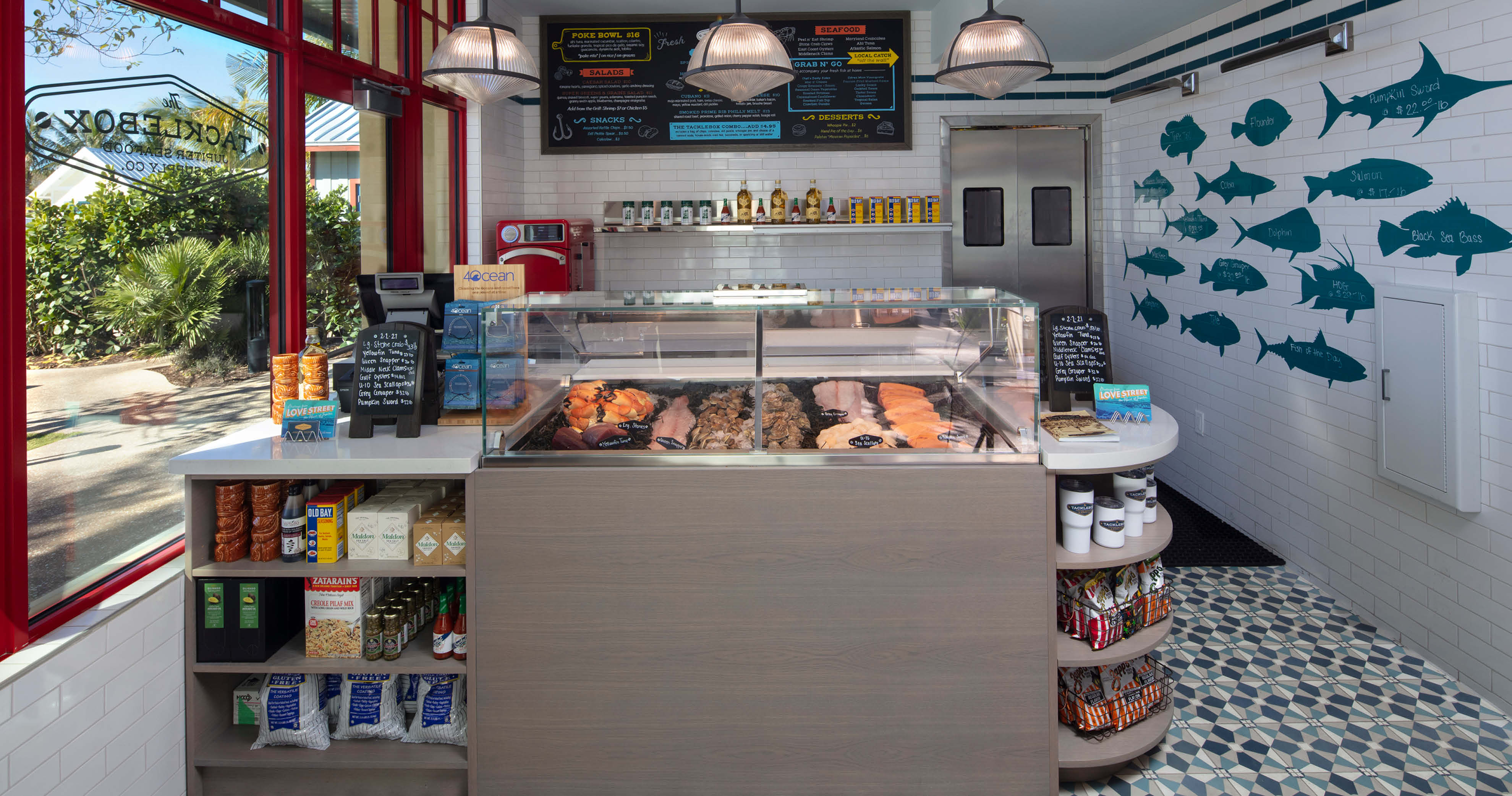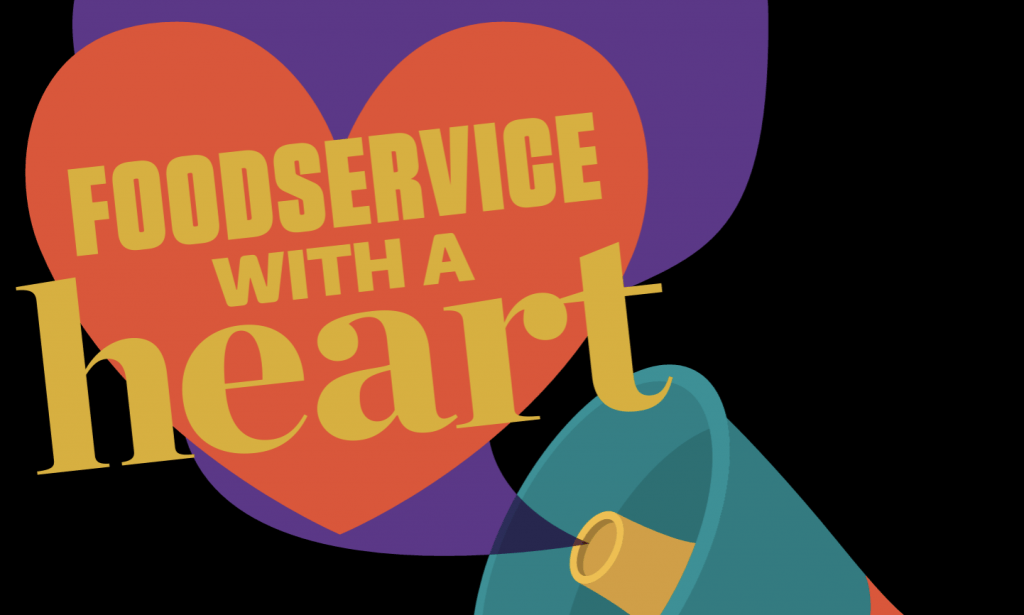
Charlie & Joe’s at Love Street in Jupiter, Florida, offers a multi-faceted hospitality experience in a setting that honors the area’s ocean-centric lifestyle. Indeed, it is being marketed as The Heart of Jupiter.
The project offered some multi-faceted challenges and opportunities for innovation for Russell LeBow Stilwell FCSI (left), the founder and principal of Next Step Design, whose mission was to help meld four distinct foodservice operations in two buildings with precious little in the way of back-of-house space.
The $30m facility officially debuted on February 18, 2021. After a decade of planning, it created 250 local hospitality jobs and bears the name of founders Charlie Modica and former NFL great Joe Namath. It includes:
- The Lucky Shuck Oyster Bar & Taphouse, offering eclectic Gulf Coast cuisine. Along with locally caught fish and freshly shucked oysters comes a selection of Southern specialties. As a taphouse, it boasts more than 40 beers from local breweries, including its signature blonde ale, Love + Passion. It also features a New Orleans-inspired cocktail menu and a curated wine list.
- The Tacklebox, a boutique seafood market offering chef-inspired takeout sandwiches, salads, and poke bowls, and an array of accompaniments to pair with the selection of fish caught that day.
- BEACON, a contemporary American grille, whose coastal Mediterranean cuisine features live, wood-fired cooking, a plethora of local ingredients, imaginative cocktails and a selection of regional wines.
- Topside, a rooftop lounge, offers tropical tiki concoctions, signature drinks, local beers and regional wines. The menu is comprised of small plates, charcuterie and a selection of skewered offerings cooked over a charcoal-fired robata grill.
- The cost of the foodservice portion of the project was $825,000 for the east restaurants (Lucky Shuck Oyster Bar, Taphouse, The Tacklebox) and $720,000 for the west units (BEACON and the rooftop Topside at the BEACON bar).
A juggling act
Jeffrey J Collins, president of Collins Development Company in Jupiter, started working on Love Street in March 2013 with feasibility studies and financial analyses, followed by a four-year entitlement process for a total six years of preconstruction efforts. “We went through multiple design/layout renditions as we balanced the requirements of the various jurisdictions, the residents’ wishes, and the market,” he says.
Managing four concepts in a single location is “a juggling act,” Collins explains. “We had multiple contractors and multiple deliveries every day, so the logistics of where to put everything was a challenge. I remember one day we moved everything from one restaurant to another so we could complete the floors.”
Establishing the necessary infrastructure to maximize economies of scale and operational efficiencies among the multiple concepts was crucial, according to Stephen Asprinio of New York City-based SA Hospitality Enterprises, who acted as the owner’s representative. “This can be achieved through the implementation of technological platforms with regard to streamlining purchasing/procurement, labor cross-utilization, COGS analytics, integrated POS, and perpetual inventory management.”
The primary challenge on the project was there are “so many concepts in such little space,” explains Stilwell. “You have a very small back-of-house and several concepts in two little buildings. It gets a bit tricky.”
Meeting that challenge meant “valuing every single inch of space and trying to utilize it the best way you can – vertically, horizontally, outdoors, and so forth,” Stilwell says. “It’s like a galley kitchen in an aircraft. We fit in as much equipment as we could and tried to do it in a way that was, at the same time, extremely functional and able to crank out a lot of volume.”
Volume was the key, as the operation has really taken off. “They have so much business they just don’t know what to do with it,” Stilwell says. “Of course, because of the pandemic the biggest problem is getting the labor to execute, but as far as the efficiency of these facilities goes, I think they’re very happy with it.”
Focus on the solution
Though every inch was needed, “you still have to follow the basics of smart flow of goods, service, and production and they all have to be done in an elegant and efficient manner,” Stilwell cautions. “Also, you have to keep trying to minimize wasted space.
“In a situation like this, when you have a huge bar – but no place to put liquor storage and a beer cooler when somebody wants a rotating section of beer, wine, and craft cocktails on 24 taps – the question becomes, where do you put it?”
That vital question caused Stilwell to look up. “I thought, ‘That’s a really high ceiling. Why don’t we build a mezzanine over the top of the bar and put the kegerator and liquor up there? And we can put windows in the kegerator and make it look like it was always intentional, like some kind of industrial pre-existing condition. So many people focus on the problem, they don’t focus on the solution. You just have to do things like that: skyhook the beer keg, which is a bit of an unusual solution but did work out well.”
In BEACON, the kitchen workhorses are the wood-fired grill and single-sided range suite from Montague. In Lucky Shuck, the workhorse “is definitely the bar because it is massive, and of course, it’s so popular because it’s on the waterside and offers beautiful views of a lighthouse and the Intracoastal Waterway,” says Stilwell. “That bar is jammed all the time.”
BEACON’s kitchen is designed to be extremely efficient, he adds, with a double-sided range suite setup that allows for much more production than a traditional straight line. “It allows you to scale up and scale down your staffing in a much more efficient way as well. So, I would say those two are the things that really keep that engine going.”
Another takeaway, Stilwell suggests, is not to detach from a project too soon. “You have to stay with it. That is one thing Next Step Design always does well. We never go away. We don’t just design a project, put it out on the street and let people do whatever they want with it.
“With this project, I think there were four different plumbers and five different construction managers. This can, potentially, cause a lot of continuity to be lost, but if you are there the whole time at least you can protect the quality of your designs and control the final outcome.”
Howard Riell




